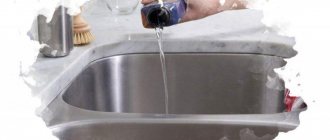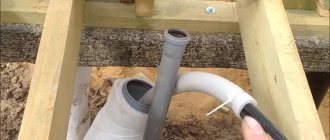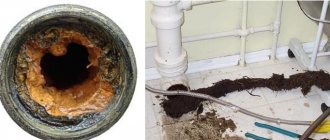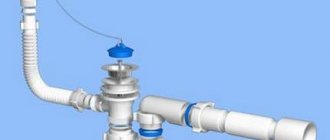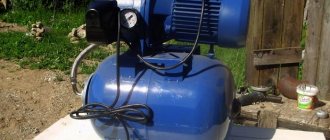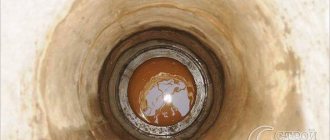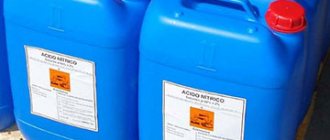Video - How to get rid of a blockage? Cleaning pipes at home. Soda Ash.
Using ordinary salt and baking soda, you can thoroughly clean pipes from fat stuck on their walls.
To prepare the product, use half a glass of salt and one glass of soda. They are mixed, poured with a glass of hot water and immediately poured into the pipe. You need to wait 5-10 minutes without turning on the water. Then you need to work a little with the plunger - press it to the drain hole and pull it sharply towards you. This is done several times. After this, you need to rinse the pipes with hot water. All deposits will be washed away!
Everyone knows that if you pour vinegar over baking soda, a sizzling foam will form. It is she who can literally help to corrode the blockage.
To do this, first pour 150 g of soda into the drain hole, followed by 150 ml of vinegar. If necessary, you can increase the volume of ingredients taken, but remember that their ratio should be 1:1.
After this, it is better to close the drain with a stopper so that the foam “works” only in the pipe. Leave it for a few minutes and then turn on the hot water - it will help flush out the clog.
If none of the ingredients listed above suddenly appear in the house, you can only use boiling water. Sometimes this is enough to clear a small blockage.
Remember that using boiling water is possible if you have steel pipes installed. Pour about a liter of water into them and wait about half an hour, then you can turn on the hot water for a few minutes.
If you have plastic pipes, you can use water whose temperature is not higher than 60 degrees. It is better if it flows for several minutes (10-20).
Even an ordinary lemon can help get rid of a blockage - just squeeze the juice out of it directly into the drain hole and leave for an hour or two. If you want to simplify this method, you can simply add a whole bag of citric acid and also wait a little. It will corrode the dirt and, perhaps, not a trace will remain of the blockage.
Oddly enough, a regular vacuum cleaner with a blowing function helps many people get rid of clogs. The pipe must be attached to the drain hole, wrapped in cloth or cellophane and turned on, leaving it for 5-10 minutes if possible. It can literally blow away the clog.
If none of the methods listed above helped you (which is unlikely), you should not immediately call a plumber - try using various chemicals. Remember that high price ≠ quality: very often even the cheapest products successfully eliminate the problem. An example of this is the famous “Mole”.
You can also use Tiret, Sanfor, Pothan and other similar chemicals. However, we hope that simple folk remedies that are truly effective will help you.
Hydrochloric acid is a reliable fat solvent. At the same time, it is a dangerous and aggressive chemical composition. It can cause considerable harm to pipelines and people cleaning them.
Many users doubt whether it is possible to clean drains with hydrochloric acid. Their fears are quite reasonable:
- the composition is capable of corroding cast iron pipes. For residents of apartment buildings, this is a very real danger, since almost everywhere in the basement the sewage system is cast iron;
- acid vapors have a negative effect on the organs of vision, breathing, and human skin. The use of protective equipment and enhanced ventilation of the room is required;
- Cleaning the sewer with acid is done blindly. The apartment owner simply pours a large amount of acid into the drain hole and waits for the result. It cannot influence in any way the quality or efficiency of the process;
- Instead of cleaning and removing the blockage, you may end up with leaks in the cast iron parts of the system, which will require serious repairs. However, the original problem will remain.
Some sources recommend using hydrochloric acid with a concentration of no more than 3-10%. In their opinion, this will help protect cast iron pipes from contact with aggressive chemicals. However, it is clearly not possible to dissolve fat deposits from many years ago in this way.
There is one more important point. Acid is poured into the plumbing drain hole. If there is water in the siphon, the concentration will drop sharply and the expected result will not be obtained. If you remove water before flushing the sewer with hydrochloric acid, the composition will only pass through the lower part of the pipelines.
Proponents of sewer cleaning using similar methods proceed from general ideas about the properties of materials. They do not take into account the multiple factors that reduce the effectiveness of the composition. Hydrochloric acid for drain cleaning gives the desired effect only at a fairly high concentration.
However, it is easier to disassemble and perform mechanical cleaning. It will take much less time and will not require noticeable effort.
Rinse the pipes with boiling water
The easiest way to implement it on your own. All you need to remove the plug is hot water or boiling water.
The procedure looks like this:
- Open the tap and fill the sink (or bathtub) with hot water. Its temperature is about +70°C. This is enough to dissolve fat. But you can also prepare boiling water by boiling water in a saucepan or kettle.
- Close the tap. We wait until the water completely goes into the drain hole.
- We repeat the procedure several times. You can tell that the result has been achieved by the rate of water drainage: when the blockage is destroyed, the sink will begin to empty freely.
The method has many disadvantages:
- First of all, its effectiveness is maximum when the blockage has recently formed. But if the cork formed a long time ago, having had time to dry thoroughly, boiling water will not be able to dissolve it.
- Another drawback is the high consumption of hot water (which will affect utility bills).
- The method is recommended only for metal pipes. Plastic pipes, as well as siphons, corrugations, and boiling water gaskets may lose their tightness.
Before flushing the pipe with boiling water, pay attention to the nature of water stagnation. If it goes down the drain until a certain point, and then starts to build up, the blockage is located too far from the siphon. In this case, the washing efficiency will be extremely low.
Flushing your pipes with hot water is easy to do and does a good job of removing fresh clogs. But still, this folk method can hardly be called a means of effectively combating traffic jams in the sewer system: it is rather preventative.
How to understand that there is a blockage in the pipes
As soon as you notice that after using the sink or bathtub, the water runs out for a long time, you can say that the pipe has become clogged. If the water does not drain at all, it means that the blockage situation has reached a critical point, or some large foreign object has entered the pipe.
In addition, an unpleasant odor, which indicates that dirt and grease residues have accumulated on the inside of the pipe, can be a clear sign of a future blockage.
Most often, the drain in the kitchen or bathroom becomes clogged. It is there that there is a lot of fat and small debris (food debris, hair) for objective reasons. The sooner you start a “war” for the free passage of water, the better. To get started, follow these simple four-step instructions:
- Boiling water. If the pipes are steel or cast iron, then you need to pour about 1 liter of boiling water into them. If they are plastic, then just run hot water from the tap in a small stream for about 20 minutes. This is an ideal way to dissolve a bar of soap that has fallen into the drain.
- Soda and salt. Add ½ tbsp to a glass of water. salt and 1 tbsp. soda, mix well and pour into the drain. After 10–15 minutes, clean it with a plunger or a rag folded into a tight ball.
- Vacuum cleaner. Quite an unusual step, but very effective. The only condition: the vacuum cleaner must have a blowing function. You need to seal the vacuum cleaner pipe with a rag and insert it into the drain. When turned on, a strong air flow will push through the resulting plug.
- Clean the siphon. To do this, remove it and, having thoroughly cleaned the inside of debris, rinse it with running water.
If the steps taken do not help, then the cork is already too dense and needs to be dealt with differently.
Before you start deep cleaning, you need to make sure that the problem is not in the sink, toilet or bathtub, but rather in the pipe. To do this, we flush water throughout the entire system and evaluate:
- water accumulates in several plumbing fixtures (for example, in a bathtub and sink), which means there is a general blockage localized at one of the points where the plumbing fixtures are connected to the sewer;
- water accumulates only in the sink (or in the bathtub, toilet, sink) - then the blockage is local, which is easiest to deal with, since it forms in the siphons, toilet water seal and filters of household appliances (washing machines, dishwashers);
- the liquid stagnates throughout the sewer system - a global blockage that requires professional intervention.
You can independently solve the problem with local and general. To do this, we disconnect the siphon, the corrugation of the sink, sink, bathtub and clean the drain holes of the sewer pipe. That is, we can pour a chemical into these holes, fill them with granules, but the main method is to clean them with a cable. And if there are no men’s hands to free the drains and work with them, then we try to influence the problem using chemical and simple methods.
If there is a blockage in the pipes, then it is necessary to clean the drains of the sewer pipes, indicated in the diagram as bends
The goal of this type of impact is to break the cork into small pieces, which can then be removed from the surface or they themselves can be easily washed down the drain. Mechanical cleaning methods are especially effective for the kitchen, where the cause of traffic jams is most often food debris.
We suggest you familiarize yourself with Soda for cleaning the washing machine from scale, dirt and unpleasant odors, reviews
plunger
This is a kind of first aid for an amateur plumber, that is, for each of us. The plunger is easy to use, and the hydraulic column that is formed due to the vacuum effect.
A plunger is a necessary device for cleaning drains that should be in every home.
Instructions:
- We fill the sink with water.
- We press the plunger to the drain and apply pressure.
- We make several forward movements, and the last, most powerful one, is to tear the plunger away from the drain hole. It is important to calculate the force correctly, otherwise you can damage the sink parts.
- If necessary, repeat 3-4 times.
To remove a blockage in the drains of bathroom or toilet pipes, you can use all of the above folk methods (with the same restrictions). But you won’t be able to use the cable in the toilet. The wire will simply run down the riser.
The easiest way to use a toilet is to use a plunger, however, it is important to choose the appropriate bowl diameter
If we are talking about a shower or bathtub, then first it is recommended to try flushing the drain with a shower hose.
Instructions:
- Remove the watering can and rubber seal from the shower hose.
- We apply a watering can to one of the drain holes and let in a strong pressure of water (preferably hot).
- Rinse for 5–10 minutes. If water flows out of other drain holes, they need to be covered with a rag.
- We repeat the procedure with all drain holes.
If the blockage is local, then most often it is located in the siphon.
Do not forget to place the container before unscrewing the siphon
Instructions:
- We unscrew the plastic nut that clamps the tube in the drain siphon.
- We pull out the siphon and lower it into a basin for further cleaning (we remove all dirt with our hands or a brush).
- Pour the soda-vinegar mixture into the pipe connected to the sewer (as described above).
- After the reaction is complete, pour a glass of vinegar into it.
- Repeat adding vinegar until the hissing stops.
- After 15–20 minutes, pour 2–3 liters of hot water (not boiling water!) into the pipe.
- We fix the siphon in place and tighten the plastic nut.
Steps 3–6 are necessary if there is a blockage in the pipe. If cleaning the siphon is a regular event not caused by water obstruction, then there is no need to use a soda-vinegar mixture.
It is logical that to eliminate the smell, you need to remove the cork - the cause of the spread of bacteria that provokes a disgusting odor.
In this case, simple tricks will help:
- Pour dry mustard into the drain, add hot water, leave for 10 minutes and rinse.
- A liquid bleach solution will also effectively eliminate the smell, although it will overpower it - not pleasant for everyone.
- Air fresheners are a quick way to eliminate the unpleasant smell from the drain, however, the problem will only be solved for literally a few hours.
A blockage is usually accompanied by an unpleasant odor from the drain.
Sometimes the cause of an unpleasant odor from the drain may be the lack of a water seal - a kind of water lock that prevents the smell from escaping from the sewer into the apartment. A siphon provides a water seal in the sewer system. Incorrect installation of the latter can cause odors to enter the rooms.
The solution to the problem depends on the type of siphon:
- If the siphon is a bottle type, then it is necessary to adjust the location of the drain pipe so that it is two to three centimeters below the water level. Otherwise, the evaporation will pass over the water lock.
- If the siphon is a pipe siphon, then perhaps the drain pipe has straightened out for some reason or was initially installed incorrectly. In this case, it just needs to be given the desired shape to ensure the formation of a normal water seal and fixed in this position with special clips.
- Operational.
You won't be able to avoid them. Grease from dishes, softened by detergents and hot water, flows down the drain, where it settles. Fatty sediment settles on the walls, food debris sticks to it, and a traffic jam occurs. 2-3 months after the start of the process, the lumen of the sewer pipe will be almost completely clogged. - Plugs of mechanical origin. They most often occur in common sewers, as well as in pipes leading from the toilet. Napkins, toilet paper, hair stick perfectly to the walls of pipes, especially cast iron ones. Dealing with such a blockage is not always easy.
- Technical. In new houses, such blockages arise as a result of engineering miscalculations - incorrect pipe diameter, angle of rotation, general slope. All types of pipes are susceptible, but most of all - corrugated ones.
Note! Blockages occur more often if the pipes are cast iron - their inner surface is rough and chipped, which means it is easier for fat to “catch” on it. With modern plastic pipes this problem is less common - their walls are smooth.
Before cleaning the sewer, you need to understand where the communications are clogged. The choice of method to solve the problem depends on this, as well as on the type of plug.
Traffic jams and blockages rarely occur on direct sections of communications. Most often, this problem occurs in places where the pipe turns, narrows, and also in the area where it joins the central riser. The last problem is typical for apartment buildings; it practically does not occur in one-story buildings.
- the water first “leaves”, then its level does not decrease - the area is clogged at a distance of more than 1.5 m from the point;
- the level drops slightly, then there are no changes - most likely the area from the siphon to the first turn is clogged;
- the water does not go anywhere - with a 90% probability there is a blockage in the siphon.
If you have modern networks, then the siphon and the adjacent pipes are made of plastic. Shine the entire route with a regular flashlight - where the traffic jam occurs, you will find a darker spot than in other areas.
Where to look for a blockage
Starting from the drain in the bathroom or sink or toilet, there is a network of sewer pipes that always tend to get clogged, and then it takes a long time to determine exactly where the blockage is and how to remove it. Directly after the drain hole at the sink or bathtub there is a siphon, at least it should be located there. Its task is to create a water plug, preventing odors and gases from spreading from the sewer into the premises, at the same time they form the first bastion of protection of the sewer from clogging.
If you find problems with water drainage in the sink, then the first thing you should check is the siphon. To do this, simply unscrew the special cap at its bottom and then empty the internal chambers. The same applies to the bathtub, although getting to the siphon is more difficult.
Next, after the siphons and toilet bowl, there are pipes. These include straight sections laid with a mandatory slope of several degrees, and elbows that allow pipes to be laid along the desired route. First of all, blockages occur in the elbows and tees. Once an object gets stuck and cannot be turned around a corner, or accumulated dirt from the constant pressure of drains, a blockage of debris is ready.
To clean elbows, there is no need to disassemble the pipes; for this purpose, sewer pipes must be inspected. Special tees in which one of the branches is simply closed with a plug. By removing it, you can access a larger section of the pipe and clean it using a cable.
If the toilet is clogged
In a toilet, the first danger of blocking the channel is in the bend, which creates a water plug. It is necessary to check its passability using a soft rod about a meter long. It is advisable that it be flexible and have a plastic head so as not to chip or scratch the ceramics.
Pipes
Sewerage is assembled from cast iron or polyvinyl chloride (PVC) pipes. The materials have good anti-corrosion properties and immunity to aggressive environments, which is exactly what is needed for transporting wastewater. However, these materials differ greatly in other respects.
The walls of cast iron pipes are rough; fats, which are usually found in abundance in drains, easily stick to them. A plaque of organic compounds often forms on the surface, which subsequently leads to blockage of the channel. For the same reason, large objects that fall into the drain easily block the channel by clinging to the walls. It is difficult to escape from this by using only chemicals to repair sewers, and the most productive method remains mechanical cleaning, where the strength of cast iron shows itself well.
PVC pipes have a smooth inner surface, which prevents the formation of plaque and does not prevent the leakage of even wastewater with a large fraction. However, the danger is caused by mineral deposits that can accumulate in sewer pipes, especially when the angle of inclination towards the riser is incorrectly adjusted. Mechanical cleaning with special diligence can lead to damage to the smooth surface of the pipe, which only accelerates further plaque formation.
How to prevent problems in the future
To understand where the blockage is, you need to put some water in the sink or bathtub and see how it drains:
- The water recedes very poorly, and it takes a lot of time. Most likely, the blockage is located further than 100 centimeters from the drain;
- The water “goes away” a little and remains in that position. The pipe clogged in the section from the siphon to the first bend;
- The water doesn't go away at all. Most often, a dirty siphon is to blame.
Now let’s look at what can cause a pipe to become clogged:
- Dirt and grease adhering to the inside of the pipe. When particles of debris begin to cling to them, this leads to a serious blockage;
- Dishwashing detergents that contain surfactants. These components create the same problem as grease and dirt;
- Limescale. It appears due to impurities in the water;
- Earth and sand. A common problem that appears in the bathroom if outdoor shoes are washed there;
- Foreign objects accidentally falling into the drain;
- Pipes made of cast iron become clogged due to the formation of rust tubercles inside them. Most often, such plaque appears in the pipe from the kitchen sink to the bathtub;
- Plastic pipes can become clogged due to improper installation. For example, if the angle of inclination is incorrect, the likelihood of a blockage increases several times.
You can clear a clogged pipe yourself. There are many different ways to do this.
Pour 200 grams into the drain. baking soda and add 200 ml to it. vinegar. After this, close the hole tightly and wait 10-15 minutes. This time is enough for the components to react and dissolve the fat formed on the walls of the pipe.
Caustic soda
To prepare the cleanser you will need 2-3 kg. caustic soda (you can buy it at a hardware store), a plastic scoop and a metal bucket.
We suggest you read: Descale an electric kettle with citric acid
Pour the powder into a bucket and add 10 liters of cold water. Stir the baking soda for at least half an hour until the powder is completely dissolved. Be careful not to get the solution on your skin. Then heat the solution on the stove to a temperature of 70 degrees. Do not let the soda boil, otherwise it will lose its properties.
Pour half the solution into the pipe and leave it for 2 hours. After the specified time, pour in the rest of the soda and wait another two hours. After this, rinse the pipes thoroughly with hot water.
Pour 100 g into the pipe. soda, and after half an hour pour 150 ml there. vinegar and chlorine. Close the hole tightly. After half an hour, you can wash off the remaining substances with hot water.
Pour 300 g into the pipe. salt, add 2 liters of boiling water and 100 ml. 70% vinegar. After half an hour, check the result. If the blockage does not go away, repeat the procedure.
Lemon acid
Pour 100 g into the pipe. citric acid, and fill it with 250 ml. hot water. After 20 minutes, rinse the pipe with plenty of hot water.
This recipe replaces the use of baking soda and greatly simplifies the process. Place a batch of tablets in the drain and then fill them with 250 ml. vinegar and 50 ml. water. Leave the product on for just a couple of minutes and rinse the pipe with hot water.
Most often, the cause of blockage is grease, which settles on the walls of the pipe if you wash dishes with cold water or a low-quality product. To avoid unpleasant consequences, try to remove food debris from dirty dishes before washing them. Once a week, run the pipe with hot water for 30-40 minutes.
Water in pipes can stagnate for several reasons:
- Cast iron pipes most often become clogged due to the appearance of corrosive irregularities on the internal walls. The section between the kitchen sink outlet and the bathroom outlet is especially susceptible to such deposits.
- Plastic pipes very often become clogged due to improper installation of sewerage equipment. The slightest violation of the angle of inclination in relation to the riser - and a jam is guaranteed.
The kitchen sink gets clogged especially often.
There are also so-called universal reasons that do not depend on the pipe material:
- Grease and dirt, sticking to the inner walls, cause small debris to cling to this coating. Gradually a dense mass is formed that does not allow water to pass through.
- Limescale deposits that settle on the walls of pipes due to impurities in the water.
- Sand and soil that gets into the sink or bathtub when washing shoes or pets.
- Foreign objects entering the sewer. You will have to call specialists who will use hydraulic installations to help cope with this problem (especially if we are talking about a high-rise apartment building), or remove the item yourself.
- Detergents with surfactants (surfactants) that enhance the ability of water to wet physical bodies. That is, the substances that make up soaps, cleaning powders and gels, etc. Surfactants act on the sewer in the same way as fat.
Thus, regardless of the material from which the sewer system is made, sooner or later everyone will have to deal with obstruction of water in the pipes. This means that you need to arm yourself with the simplest (but at the same time effective!) ways to solve the problem.
plunger
Stagnant water is not always a consequence of a clogged drain hole. Sometimes the reason lies:
- in a clogged siphon (often construction debris ends up there after repair work);
- in the incorrect bending of the corrugation that goes from the siphon to the sewer (if the siphon is a bottle type, then there must be a side outlet and an elongated lower part for the accumulation of water; if the siphon is a pipe siphon, then one of the pipes of the system must have a curved shape);
- plugs at the joints of silicone pipes, which were used to process these same joints.
You can solve the problem by eliminating the root cause:
- clean the siphon;
- check that the bend of the corrugation matches the type of siphon;
- remove the silicone plug (carefully clean it with sandpaper or the blunt side of a knife).
The sewer system moves wastewater with a high content of organic matter and fats. They stick to the walls in a thin layer, which gradually grows and turns into a full-fledged blockage. As a rule, it is located near the drain hole of kitchen sinks or other plumbing fixtures. Most often, the siphon suffers from fat deposits, the bend of which actively collects sticky and viscous components of wastewater.
In addition, a common cause is foreign objects falling into the sewer. There may be hair, paper, construction waste (sand, residues of adhesive solutions), feminine pads and other unwanted components. They get stuck in bends or narrowing areas of the pipes, causing permanent blockages. No methods other than mechanical cleaning give results.
On cast iron pipes, there are cases of scale detachment from the inner surface of the walls. It remains inside and quickly becomes overgrown with fat, trapping small particles of organic matter. Mechanical cleaning of pipes will also be a solution to the problem.
Why do pipes get clogged and what to do about it?
Before discussing folk recipes for cleaning sewer pipes, you need to understand how the sewer system works. This will help you understand the causes of blockages, as well as find out what you can do to dissolve the resulting blockage. Of course, there are significant differences in the design of the sewer system in different buildings, but the general principle is the same everywhere.
As a rule, every house has the following elements of the sewer system:
- Main riser. This is a vertically installed large-diameter pipe through which wastewater is carried away from the apartment. It clogs extremely rarely. It should be said right away that if the riser is clogged, folk remedies are not enough.
- Sun beds. These are horizontally located pipes connecting the kitchen sink, bathtub, toilet and other plumbing fixtures to the riser. In sunbeds, blockages most often occur at the joints with the riser or siphons.
In order for waste to be drained by gravity from plumbing fixtures, the deck chairs must have a sufficient slope. If there is no slope, blockages are inevitable. Traditional recipes will help cope with a specific problem, but will not prevent the appearance of new blockages. Therefore, if the slope of the sunbeds is insufficient, major repairs will have to be carried out.
- Siphons and connecting corrugations. These are parts of complex shapes with ribbed surfaces. They create water seals - layers of water that prevent gases from the pipes from entering the home. Siphon bends are the most common place for blockages to form. Since the siphon is located closest to the drain hole, the use of folk recipes for cleaning it is most effective.
With the exception of cases where large foreign objects (rags, tufts of hair, etc.) get into the sewer system, the main cause of blockages in a properly constructed system is fat deposits in the pipes. If the system is not flushed with a sufficient amount of hot water (with modern economy, this often does not happen), grease is deposited on the walls, “cements” large particles that fall into the drain, and blocks the lumen.
The most effective method in dealing with blockages is the chemical method. It involves dissolving fatty deposits with chemically active substances. After the deposits cementing the blockage disappear, the water pressure will push large particles further through the system, and the blockage will be eliminated. This is exactly how all pipe cleaners work: from store-bought “Mole” to folk recipes.
Which cleaning method to choose in which case?
For fresh clogs formed by mucus and dirt, you should choose all the recipes using baking soda and Mole. If the clog is caused by stuck hair, use Floop.
For old traffic jams, Mister Muscle, Pothan, Alco-Seltzer and caustic soda are suitable. In addition, such a blockage can be eliminated with a plunger, which will simply break it.
Citric acid removes limescale plugs. For cast iron pipes, a recipe with coarse salt is suitable. For plastic pipes you can use Mole or Pothan.
If you need to remove a foreign object, use a plumbing cable or disassemble the siphon.
Household chemicals will help remove blockages
If the sewer is clogged, you can clear the pipe blockages with your own hands using available substances. Or you can resort to the help of special chemicals that are sold in household chemical stores (for example, “Mole”).
There are many different brands and types of bathroom clog cleaning chemicals available. The most famous and popular:
- "Mole";
- “TIRET”;
- "DOMESTOS";
- "SANFOR".
Chemicals for cleaning pipes
From the presented list, “Mole” is the most accessible remedy for the general public. The fairly low price allowed it to become especially popular. In addition, “Mole” is the simplest method for removing sediment from sewer pipes. This chemical is produced in Russia.
It is worth noting that sewer cleaning can be successfully carried out with any of the presented means. Manufacturers note that it is enough to pour a product (for example, “Mole”) into the drain, wait a while, and sewer cleaning will be completely completed without any additional actions.
Although chemical manufacturers claim that flushing can be done in this simple way, it is often necessary to additionally use a plunger. Its use allows fat deposits to finally go down the drain.
Special chemicals
Mr. Muscle
The powder does a good job of removing clogs and disinfecting the surface of the pipe. Pour the contents of the bag into the pipe, and carefully pour the powder with a glass of warm water. After half an hour, rinse the drain thoroughly. One bag is enough to deal with the blockage, and it costs no more than 100 rubles.
This is a very inexpensive domestic product that can be used to remove completely different blockages. Pour in 200-250 ml. into the drain and leave the product for 2 hours. After the specified time has passed, rinse the pipe with strong water pressure. If the blockage cannot be cleared the first time, use the product again. Mole costs much less than imported analogues, no more than 70 rubles.
Pothan
Before use, lower the water level in the drain by 5 cm. Then fill in 100 ml. products and 100 ml. boiling water After 5 minutes, rinse the drain with warm water. The product is suitable for all blockages in cast iron and plastic pipes.
Pour the product into the drain and add hot water. The required proportions are indicated on the packaging. Then rinse the drain thoroughly with cold water. The product is very caustic, so put on gloves, a respirator and a protective apron or special suit before using it.
There are methods that will help get rid of a blockage in the pipe. You can implement them at home without much expense, since everyone has the proposed materials and tools. However, they are not suitable for every case and are not always effective.
This option is the simplest. All you need is boiling water and coarse salt. Can be used to clean cast iron non-separable siphons in the kitchen sink. You can add citric acid as an enhancer.
- If there is any water left, remove it and dry the sink.
- Pour 200 g of salt into the drain hole ("extra" is not suitable).
- Pour two liters of boiling water into the drain.
- Wait 30 minutes and check the result.
- If necessary, repeat the procedure.
This method is not suitable for cleaning plastic pipes (due to their sensitivity to temperatures of 1000C), as well as for bathtub and toilet drains. The reason is that salt and boiling water are effective only against fatty plugs; they cannot cope with mechanical blockages.
We suggest you read How to remove stains from clothes at home
It’s not for nothing that this method is called environmentally friendly - it is not harmful to the person who uses it and to pipes. You will need baking soda, white vinegar and boiling water. Also have a rag or sponge ready to cover the drain hole.
- Pour half a pack of dry soda down the drain.
- Pour 0.5 cups of preheated vinegar
- Cover the drain with a rag or sponge so that the reaction between vinegar and soda occurs inside the pipes.
- Leave everything for half an hour.
- Pour 1.5-2 liters of boiling water into the drain.
After this procedure, the water should drain easily. The method is especially useful when forming a fat plug in remote places of communications.
This method is similar to expensive pneumatic cleaning, but uses a vacuum cleaner with a blowing function. To ensure that the pipe fits tightly into the drain, wrap it with a rag. Turn on the vacuum cleaner at full power and the air flow will push even complex blockages through the pipe.
To remove the blockage, you can use ready-made products. You can find them in any household chemical store. The table shows the most effective ones, according to reviews from housewives.
| Name | Purpose | Instructions for use |
| "Mole" | Fighting blockages in the sink, bathtub, toilet | Pour 200-250 g of product and leave for 2 hours. Drain off the water generously. For prevention use once a month |
| "Debouche" | Removing fatty and mechanical blockages in sewer pipes | Pour 0.5 liters of liquid into the drain and leave for 2 hours. If the blockage is severe, pour 1 liter overnight. After the procedure, rinse the pipes with plenty of water. |
| Bagi "Pothan" | Removes any blockages in plastic and cast iron pipes | Lower the water level in the drain by 5 cm, carefully pour in 100 g of product and the same amount of boiling water. After 3 minutes, drain the water thoroughly. |
When working with Bagi “Pothan”, be careful, pour liquids from an outstretched arm and turn your head to the side to avoid chemical burns.
Manufacturers of household chemicals offer a wide selection of special products:
- liquid (for example, “Tiret” (without the smell of ammonia), “Mr. Muscle” (with the smell of ammonia) - act gently on the material, but remove blockages effectively, especially in plastic);
- powders (for example, “Komet” - not always convenient to use, especially if the water does not drain completely);
- acidic (for example, “Mole”);
- alkaline (for example, “Belizna”, “Domestos”).
Despite the advertising, these products (especially alkaline and acidic ones) in practice should not be used frequently for cleaning plastic pipes. Moreover, on the Internet you can find thousands of “horror stories” about how the “Mole” corroded a pipe. Of course, a lot depends on the quality of the plastic, but nevertheless, using chemicals more than once a month is not recommended.
Pipe cleaners are included in the product lines of all major household chemical manufacturers
Location of the blockage
Finding out the exact location of the plug is important in order to choose the right product for cleaning sewer pipes. First, you need to open all the taps: in the bathroom, in the kitchen, in the shower, and flush the toilet. Where the water does not drain well into the pipes, a characteristic odor will appear, and a plug will form there.
If water stagnates in one place: for example, in the kitchen sink or in the toilet, then this is a local problem, but if the water does not flow well at all points, then the entire system is clogged.
Having decided on the location and cause of the blockage, let's consider how to deal with traffic jams.
The sewage system is clean, but the water does not go away: causes and solutions to the problem
plunger
This tool is in every home, but not everyone knows how to use it correctly. Follow these tips:
- Drain the sink, leaving some liquid at the drain;
- Lubricate the edges of the plunger with grease or Vaseline, this will help attach it more tightly to the bottom of the sink;
- If you have multiple sinks or bathtubs in your home, secure their drains;
- Place the plunger directly on the drain hole and make several active pressing movements;
- If the blockage does not go away, repeat the procedure. If everything works, rinse the drain with hot water.
Plumbing cable
You can buy a special cable or use regular unannealed flexible wire.
Instructions for using a plumbing cable:
- Remove the siphon;
- Run one end of the cable into the pipe;
- Push the cable. Simultaneously rotating it in one direction;
- If the cable is stuck, pull it back without ceasing to rotate;
- Try pushing the cable a couple more times and pull it out;
- Clean the end of the cable. And we run it into the pipe again until it is completely clean.
Disassembling the siphon
- Place a small basin under the pipe that you will dismantle;
- Unscrew the lock nut that holds the siphon tube;
- Clean the dirty siphon using a brush and hot water;
- At this time, you can already pour any anti-clogging agent into the pipe. Do everything as the instructions say;
- Return the siphon to its place.
The most effective methods include mechanical cleaning. It is simple and easy to do yourself. A plumbing cable is used, which is inserted into the pipe and pushed inside with rotational movements.
When contact with the blockage occurs, the cable tip destroys the plug. After this, the internal cavity of the pipelines is washed with a strong stream of water.
There is hydrodynamic cleaning. It is produced using special equipment. The essence of the method is to immerse a thin hose with a special tip, from which a stream of water shoots out under strong pressure. The effectiveness of this method is higher than that of alternative types of cleaning.
The use of chemicals, as a rule, is carried out only to clean the internal areas of the system. There are many formulations on sale that contain alkaline or acidic components. Sometimes drain cleaning with hydrochloric acid is used. This is an extremely dubious and dangerous method that can do more harm than good.
If there are no means at hand, salt is often used to clean the drain. It is poured generously into the drain hole and left for some time. Salt eats away fat deposits and makes them loose. After some time, the siphon is washed with a strong stream of water, removing organic particles.
To enhance the effect, make a mixture of soda and salt. The proportions vary, but the effect is usually the same. Please note that regular baking soda is not suitable. You need a caustic that can effectively interact with fats. In addition, caustic soda can dissolve more complex blockages. For example, hair that does not interact well with most chemicals.
However, this method is only suitable for blockages located near the drain. If the problem section of the pipe is further away, more radical remedies are needed.
This group of methods is aimed at destroying/pushing and physically removing the blockage. You can clean the pipe using a plunger or a plumbing cable.
This device will help clear clogs in the sink, toilet, or bathtub. Due to the artificially created vacuum, it is possible to destroy the blockage and push it further along the pipe or “pull it” closer to the drain and pull it out.
- Dry the drain and lubricate it with Vaseline.
- If there is an overflow hole, close it as tightly as possible (if open, it will interfere with air injection).
- Place the plunger over the drain and press firmly. Pump the pump several dozen times.
- When moving up, do not remove the rubber part from the drain.
- Repeat the procedure if necessary.
If a blockage has formed in a full sink or bathtub, then the plunger should be immersed in water at an angle of 45⁰ and covered with it over the drain. Then it will be possible to “squeeze out” the water and ensure a tight fit.
This device helps to get out the blockage that is located far in the communications, on the bends. The main task of the cable is to hook the blockage and pull it out. There is a sharp hook at the end of the cable that can damage plastic pipes, so they need to be careful.
- remove the siphon and insert the cable into the sewer pipe;
- screw and push it clockwise gradually and without sudden movements;
- If you feel an obstacle, remove the cable (this will remove the mechanical blockage).
Note! If the blockage is large, then several visits will be required, because it will not be possible to remove it immediately.
Features of application
Liquids from the store act faster than bulk drugs, which must be dissolved in water to be effective. If there is water in the sink, it should be poured out so as not to dilute the product, because water will neutralize the acid and reduce its effectiveness. The same goes for pills.
Bulk concentrated alkalis can work even in water, but more substance is required. If the blockage is very strong and the bathroom is completely filled with water, then it is better to scoop it into the toilet, and then add a substance that will corrode the organic matter in the pipes and clear the passage for water.
Traditional methods
You can also clean pipes using means that have been tested more than once.
Soda and vinegar
Instructions:
- Pour baking soda into the drain and add vinegar in a 1:1 ratio (for the first time, you can take ½ tbsp).
- We close the hole with a plug.
- After 5–7 minutes, rinse the drain with a small pressure of hot water.
Baking soda and vinegar are the most famous folk remedy for cleaning drains.
Soda and vinegar
When the soda and vinegar react, they create strong pressure, which quite quickly breaks through the plug formed in the pipe. Thanks to this property of soda and vinegar, recipes with these ingredients can be used to remove more serious and long-standing clogs.
Please note that when they react, soda and vinegar release caustic substances that can easily poison a person. Therefore, always have something ready to tightly plug the drain when using such recipes.
Recipe No. 1
You will need:
- Half a pack of soda.
- 100 ml. vinegar.
- 2 liters of hot water.
Pour baking soda into the pipe, then carefully add vinegar. As soon as the reaction begins, cover the drain with a rag or lid. As you already know, this is necessary to protect the room from harmful substances released when combining soda and vinegar. After 20-30 minutes, open the drain and pour hot water over it.
Recipe No. 2
You will need:
- 100 gr. soda
- 100 ml. vinegar.
- 2 liters of hot water.
Gently mix the vinegar and baking soda in a glass or clay bowl, then pour the mixture down the drain. After this, cover the drain with a rag or lid. After 1.5-2 hours, pour boiling water over the pipe.
